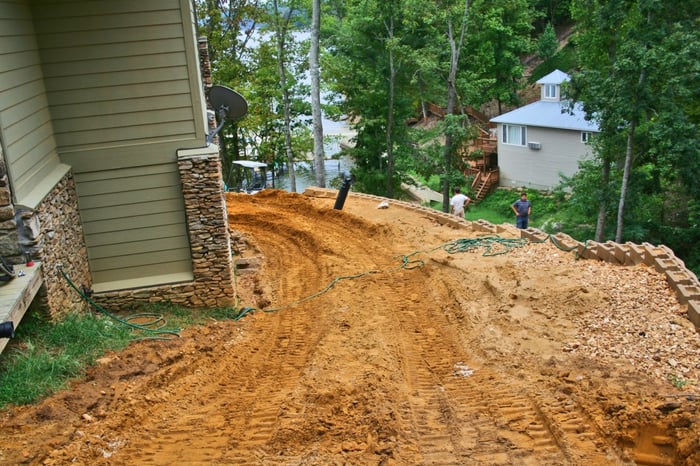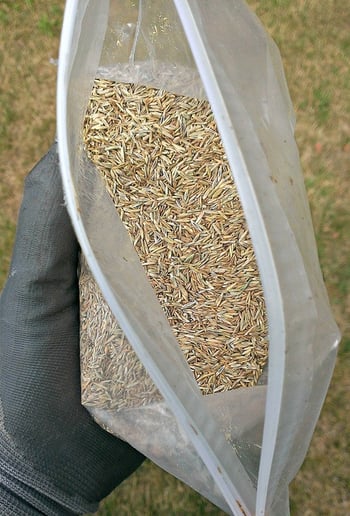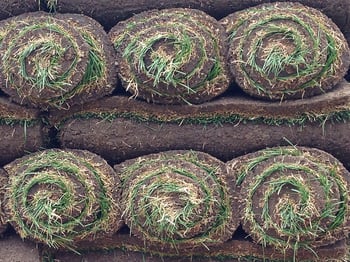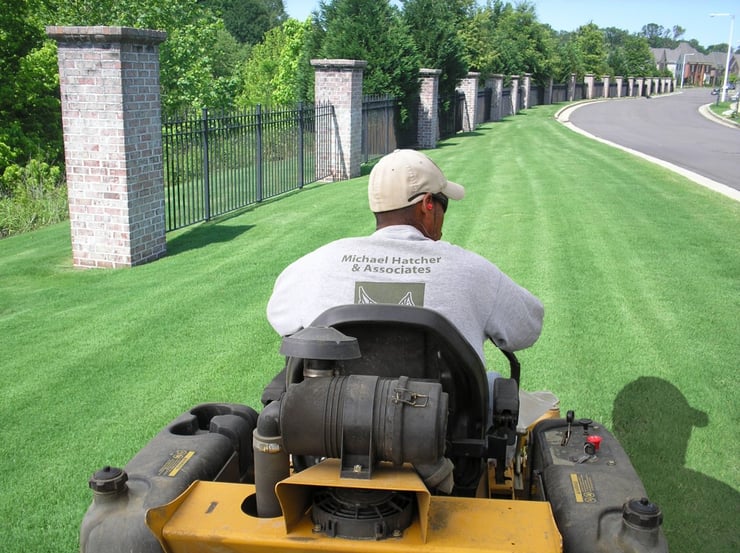 So you are planning a new lawn, or need to restore an existing one. Should you seed or should you sod?
So you are planning a new lawn, or need to restore an existing one. Should you seed or should you sod?
At first glance, seeding may appear to be a better deal. After all, grass seed is less expensive than sod.
However, as with many things in the landscaping business, upfront cost doesn’t always provide a reliable reflection of value.
Let’s take a closer look at seed vs. sod, the various options for each, and how they will meet your needs as a property owner.
Growing Turf From Seed In The Memphis Area
In our area, the ability to successfully grow turf from seed depends on time of year.
You will need to select a grass variety suited to the season.
Cool season grasses such as Fescue, Kentucky Bluegrass and perennial ryegrass (or a mix or blend of all three) are best planted in the fall (starting around Labor Day). These do best when allowed to germinate while the days are still fairly warm, so that they can establish good root growth going into the cool part of the year.

The idea is to give them a healthy start in the fall, so that your turf will be vigorous, resilient, and able to take the heat come spring.
Keep in mind that cool season grasses typically take 7-14 days to germination, so be sure to seed no later than the first of November in our area, and preferably earlier.
In late spring and summer, warm season grasses are the way to go. These include zoysia and common Bermuda, but we highly recommend sticking to Bermuda. Zoysia seed is not readily available. It is also expensive, and difficult to grow from seed.
A good rule of thumb for seeding warm season grasses is that it is safe to plant in any month that does not contain an “r”: May, June, July, and August. A more scientific method is to add your daytime and nighttime high temperatures together. If they equal 150 degrees, it’s optimal weather for growing Bermuda grass.
Traditionally, grass seed is broadcast over prepared soil either by hand (for small areas) or with a broadcast seeder. To help retain moisture in the soil, a thin mulch is applied. Often, loose straw or straw blankets are used for this purpose.
For areas subject to erosion, hydroseeding is an option that can help to hold the grass seed in place until germination. With this technique, turf seed is mixed with mulch in a wet slurry, then sprayed onto the ground. This method tends to hold moisture in the soil better than broadcast seeding. It is also a much faster method for seeding large areas.
Ins And Outs Of Installing Sodgrass
Sod consists of mature turf that is removed from its nursery plot (sod farm) and transplanted directly onto your lawn or athletic field.
You can get sod in squares or by the roll. Using a roll is quicker but requires a tractor or Bobcat with a special implement for sod installation.
For small areas where equipment doesn’t have much room to maneuver it is better to use squares. For large, wide open areas rolls are more efficient. We routinely use both, depending on the size and scope of the project. Sod can be installed at any time of the year.
Seed Vs Sod: Advantages And Disadvantages
The three biggest things to consider when choosing between seed and sod are variety selection, maintenance, and budget.
Let’s compare seed and sod for each of these factors.
Turfgrass Variety Availability In Seed Vs Sod
For cost savings on large acreage areas, growing from seed has the advantage — sodgrass is typically only available in a few single varieties.
The main two sod varieties we use are Bermuda Tif 419 and Meyers zoysia, which are both readily available throughout the year. For most applications this works well, but if you have an area where you want to grow a mix of turf species, you probably will need to go with seed.
Establishing New Turf Grass: The Choice Is Clear
 On the other hand, when it comes to maintenance, sod is the clear winner.
On the other hand, when it comes to maintenance, sod is the clear winner.
It looks beautiful immediately. It is best to stay off it at first, but once the roots have had a chance to tack themselves in it can be mowed and maintained like any other lawn.
This process typically takes about a week or two, and the new lawn should be watered well during this time.
In contrast, a freshly seeded lawn requires considerable care for weeks. You will probably have to lime and fertilize the area, and it is more time consuming to water properly. The soil should be kept moist but not to the point of runoff. It should not be allowed to dry out.
If you plan to seed we recommend having an in-ground sprinkler system set to deliver frequent but light watering throughout the day for several weeks. Once germination has occurred, plan to stay off the area for at least three weeks for cool season species, and at least 4- 6 weeks for warm season types.
How Does Budget Figure In?
Seeding is a more economical option, especially for large areas.
You can expect to pay approximately $70.00 per 1,000 feet for over-seeding an area with common Bermuda. This includes light tilling and raking to the soil so that we have a good seed bed to put the seed down in. It also includes a start-up fertilization to help the seed establish.
In contrast, installing the same area with Bermuda sod would cost in the ballpark of $350.00. This includes start-up fertilization as well as tilling, raking ,and cutting the sod in to match up with any existing sod, so that the sod lines are seamless.
Why do most of our customers prefer sod?
 Even though seed is cheaper, we sod far more often than we seed a lawn.
Even though seed is cheaper, we sod far more often than we seed a lawn.
This is because seeding will rarely yield best results unless you have an adequate irrigation system in place or are willing to spend a lot of time caring for your new lawn as it gets established. You will also wait weeks before your lawn looks presentable.
Seeded areas usually take 2-3 weeks to germinate, so be prepared to look at a bare lawn during that time. You will need to water your newly seeded lawn twice a day for 8-10 minutes the first few weeks. After it germinates you can put it on an every other day watering schedule for 10-15 minutes a day. However it will be about 6 weeks or so before you can cut it.
A new sod lawn is much easier to maintain than seed. New sod does need to be watered a lot, but only once a day for 12-15 minutes. It usually starts rooting in within a couple of weeks, and can typically be cut at only about 3 weeks after planting.
After it has rooted in, it can be treated like the mature turf it is and put on a normal every other day or 3 times a week watering schedule. When you take into account the time you will spend (or have us spend) in caring for the seedling turf, the overall cost difference is not as great as it might first appear.
And because you have a finished product from the start, a new sod lawn looks great from the get go.
Still Not Sure Which Is Best For You?
If you would like help determining the best course of action for your new lawn, call us at 901-755-3207. One of our lawn care experts will be happy to help.
Image Credit: Grass Seed, Sod Roll


